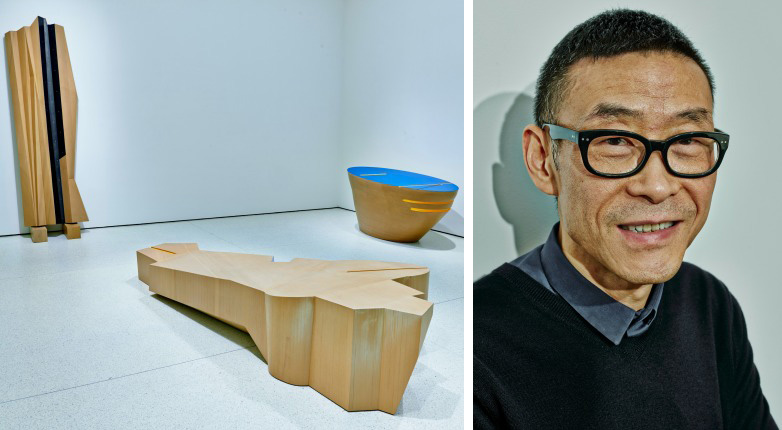A pioneering figure of China’s post-Mao avant-garde, Wang Jianwei is known for producing challenging works that defy easy categorization. In a recently opened solo exhibition at New York’s Guggenheim Museum, “Time Temple” (through Feb. 15, 2015), the Beijing-based multimedia artist offers a contemplation of the ineffable nature of time and space, the iterative process of art making, and the subjective act of viewing itself.
The ambitious undertaking is organized in three parts: The first, installed in a gallery space, collects paintings and sculptures under the title “Time Temple.” The second is “The Morning Time Disappeared,” a 55-minute film, screened once daily. Set in modern-day China, it loosely interprets Kafka’s 1915 novella The Metamorphosis. The third, “Spiral Ramp Library,” is a live two-part oral performance. (The first took place at the start of the exhibition this fall, in the museum’s rotunda; the second will occur in an auditorium, upon its close.) Dexterously navigating cultural references and multiple media forms, the presentation is a survey of sorts into Wang’s philosophical—if slightly impenetrable—turn of mind.
Organized by Guggenheim curator Thomas Berghuis, the exhibition is Wang’s first solo show in North America, and the inaugural commission for the museum’s Robert H. N. Ho Family Foundation Chinese Art Initiative dedicated to expanding discourse on contemporary Chinese art. (Cai Guo-Qiang’s 2008 exhibition, “I Want To Believe,” served as an early precedent to the program.) As its title suggests, Wang conceived of the show as a place at which to contemplate time. Translated from Chinese, the phrase “temple” doesn’t necessarily carry a religious connotation as it does in Western cultures; rather, in ancient terms, it indicates a place where time pauses and condenses. Even in Chinese venues of worship, “there may be a sculpture of Buddha, but Buddha is not in the temple—it’s just a construction through which people can pay worship to the Buddha,” Wang says. “I’m trying to provide that same kind of position, to facilitate thinking about contemporary art and philosophy. ‘Time Temple’ is about how to think about subjectivity created by time.”
The heady concept was spurred in part by Wang’s recent readings on string theory—a shared interest of Berghuis that was discussed early on in the project’s planning stages. At its most basic premise, the complex framework of theoretical physics argues that particulate matter comprises one-dimensional “strings” that reverberate and move in many more dimensions than can be seen or understood by the human eye. “Through contemporary science, we’re able to fathom the world through multiple dimensions,” Berghuis says. “More than four dimensions—we’re now talking about 11 dimensions of time and space.”
Touring the gallery of Wang’s paintings and sculptures, elastic tensions vacillate between time and space, reality and fiction, movement and stagnancy. For the installation, Wang produced two paintings—or six, depending on how one counts them. The first spans nearly an entire wall, comprised of four panels installed at alternating depths. Wang regards the tableaux as neither a single painting, nor as a set of four, saying, “I don’t reject the idea if someone wants to perceive it as all the same painting. A key concept of this project is ‘potential time’—each object and event can either stay in one state or another state: There’s an uncertainty to it.” At once fragmented and whole, like jump cuts spliced together on a film reel, they indicate a lapse of time within the seemingly static medium. Installed on the opposite wall is a more abstract painting that, depicting a vaguely architectural form set against a neon orange canvas, could arguably stand as a realist representation of a plant cell’s rigid membrane.
Meanings ricochet between the paintings and a group of polymorphic wooden sculptures, situated at the gallery’s center. Appearing like a set of digital 3-D renderings made physical—though entirely fabricated iteratively by hand—each presents a complex visual puzzle. Shadows mutate from one plane to another as viewers shift position in relation to the works; accents of steel, brass, rubber, and blue and yellow obscure the experience. Here, Wang’s use of yellow seems a direct reference to his 2011 solo show at Beijing’s Ullens Center for Contemporary Art, “Yellow Signal,” which explored the state of “in-between” and pause. As for the use of blue and other details, though, even Berghuis admits, “I’m concerned I’m still working it out.”
Together with the film and performance components of the exhibition, Wang argues that all art forms are time-based, each crystalizing an irreplaceable moment within a continually evolving act of rehearsal. “If you look at rehearsal as a way of opening, then each rehearsal is in anticipation of a rehearsal, and each rehearsal is the result of another rehearsal,” he says. “So it’s the end as well as the means. It’s not about rehearsal in the conventional sense of a theatrical work—in which one aims to make everything better and better within a confined space.”

